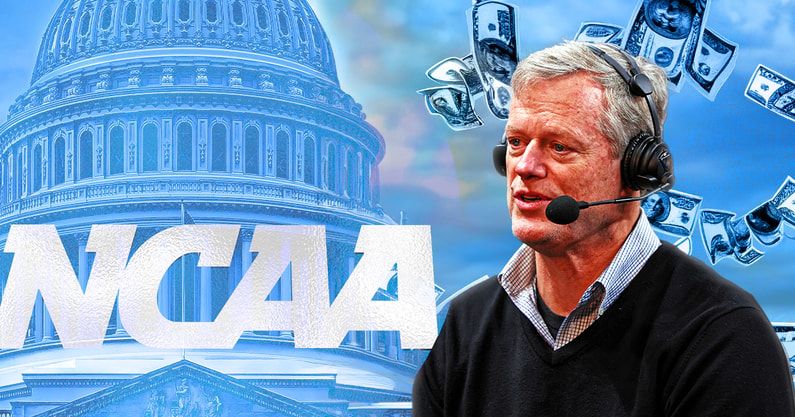Report: NCAA president Charlie Baker earned $3.4 million for first year in role

A new report from USA Today revealed the salary for NCAA president Charlie Baker. He received a little more than $3.4 million in total compensation over the final 10 months of 2023 following his hiring on March 1, 2023, according to NCAA tax records obtained by USA Today’s Steve Berkowitz.
The documents, which were provided to Berkowitz earlier Friday, also revealed former NCAA president Mark Emmert received a severance packed of roughly $4.3 million during the 2023 calendar year. That was in addition to more than $1.4 million in base salary and $600,000 in other benefits over his final few months with the organization, according to Berkowitz.
Baker’s annual NCAA salary includes roughly $2.6 million in base pay, $400,000 in bonus pay and nearly $360,000 in other reportable compensation, per Berkowitz. That’s an annual compensation of more than $3.15 million. It is an increase from Emmert’s annual base compensation of nearly $2.85 million in the 2022 fiscal year, his final full year as NCAA president.
Charlie Baker pens letter to NCAA membership after House v. NCAA settlement approval
NCAA president Charlie Baker has been in the news lately, given his role as a lead defendant in the recently resolved House v. NCAA settlement, which California district judge Claudia Wilken formally approved June 6. Following that late Friday night approval, Baker issued a statement to NCAA membership, explaining what’s next for college athletics.
Baker called final approval a “new beginning” for college sports now that revenue-sharing is on the way, as well as roster limits. Schools will soon be able to directly share up to $20.5 million with athletes in the first year of the settlement agreement, and that figure will go up 4% each year for 10 years.
While April’s final approval hearing was a date many circled, Baker said Friday will be the moment the “new beginning” for the NCAA. He also noted the trouble enforcing NIL rules and the way the landscape transformed as a result.
“Many looked to April’s hearing about the House settlement as a culmination of sorts, but the court’s final approval of the settlement in fact marks a new beginning for Division I student-athletes and for the NCAA,” Baker wrote. “For several years, Division I members crafted well-intentioned rules and systems to govern financial benefits from schools and name, image and likeness opportunities, but the NCAA could not easily enforce these for several reasons.
Top 10
- 1
Jake Retzlaff
Plans to transfer
- 2New
SEC order of finish
Phil Steele predicts
- 3
Arch Manning
2-minute advice from Peyton
- 4Hot
Miss Terry
Saban credits wife for LSU job
- 5
Garrett Nussmeier
Reacts to Daniels, Burrow comps
Get the On3 Top 10 to your inbox every morning
By clicking "Subscribe to Newsletter", I agree to On3's Privacy Notice, Terms, and use of my personal information described therein.
“The result was a sense of chaos: instability for schools, confusion for student-athletes and too often litigation. Sometimes member schools even supported that litigation, some of which spurred hastily imposed court orders upending the rules.”
Baker also noted the NCAA’s continued role in regulating other areas, as well as managing the back damages part of the settlement.
“Beyond the rules that will be managed by the defendant conferences, Division I will continue to regulate in key areas (e.g., eligibility, playing seasons, sports betting and minimal recruiting rules) while prioritizing educational success through setting and monitoring academic standards,” Baker wrote. “The NCAA will finance the back damages portion of the settlement. To do that, we are both reducing costs and generating more revenue, all while investing in the student-athlete experience.
“Together the NCAA, the defendant conferences and the Division I membership have identified the existing NCAA rules that must change to reflect the settlement. These include replacing scholarship limits with roster limits — a change that will enable schools to vastly increase the scholarship opportunities student-athletes receive and potentially double the number of athletics scholarships made available to women.”
— On3’s Nick Schultz contributed to this report.